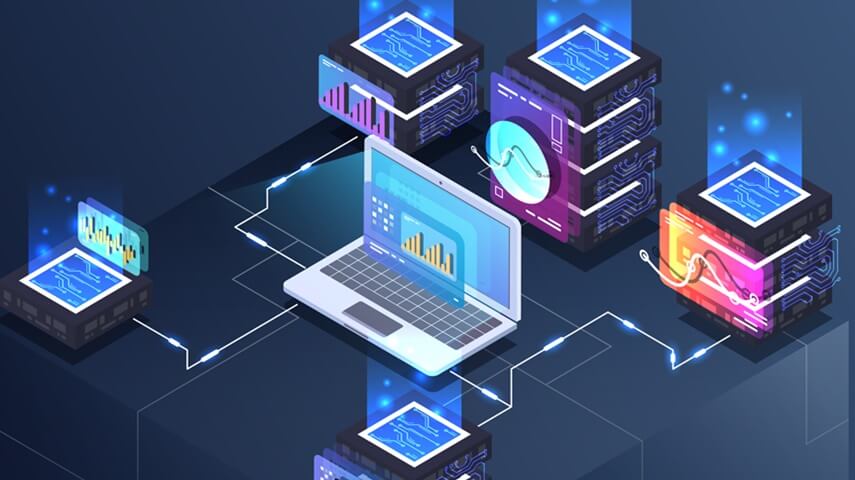With cloud computing, your entire IT infrastructure is hosted online which includes both hardware and software. Some of the most popular cloud computing applications include Gmail, Facebook, Alibaba, Amazon, etc. You need an internet connection to access the remote servers where data and applications are hosted. Cloud computing services are accessible everywhere, in most cases, only requiring authentication to access the servers or software data. It has become a preferred option for companies of all sizes due to the centralized access of data and services and the flexible pay-per-use model. Before we dig deeper into the history of cloud computing, let’s look at the cloud computing models in the market today.
Primarily, users can access three types of cloud computing deployment models as described below. While there are other types of classification, the following are based on the deployment model.
1) Public Cloud
A public cloud is a large pool of computing infrastructure available to the general public on a subscription basis. This type of deployment is physically inaccessible to the end-user since it is located somewhere far away in the vendor’s data centres. Some examples include Alibaba Cloud, Microsoft Azure, IBM SoftLayer, and Amazon Cloud. It is the cheapest among the cloud options available.
2) Private Cloud
A private cloud is a pool of computing resources that hosts a single enterprise only. It is similar to public cloud computing in many ways but the difference is in the access of resources. A private cloud hosts the resources of a single customer, thus, it’s more secure compared to a public cloud. It also offers better privacy since it is hosted on internal company servers using some virtualization technology. VMware is an example of a private cloud.
3) Hybrid Cloud
A hybrid cloud is a combination of public and private clouds, and usually offers the best of both worlds. Sensitive data could be hosted within the private cloud while other resources are hosted in the public cloud. An organization could also revert to the public cloud to handle excessive traffic.
4) Developments in Cloud Computing
Over the last ten years, cloud computing has become the backbone of modern technology, supporting millions of companies all over the world. Looking back, however, the cloud model of computing has gone through an interesting evolution to reach today’s levels. We have seen the model evolve from grid and utility computing, delivering applications, software as a service (SaaS), and finally to a world-wide delivery of computing resources. The turning point can be traced back to the 1960s with the introduction of the Advanced Research Projects Agency Network (ARPANET) and the Intergalactic Computer Network. It was the first time that the idea of a globally interconnected network was conceived and led to grid computing development. Grid computing involved the linking of computers dispersed over a wide geographical area into a loose network. This then led to utility computing, much close to the originally intended model of ARPANET.
The most significant change came in the 1990s when the internet bandwidth became significantly large enough to allow a boom in web development. It was in the 1990s that the first enterprise applications were served via a web application by Salesforce that sparked a revolution in application delivery. It is what led to stiff competition among top software companies, including Microsoft, Oracle, and SAP, to adopt the SaaS model. This developed even further in 2009 with the emergence of browser-only applications such as Google Apps and Office 365.
4.1 On-premises vs. Cloud Delivery (SaaS)
Gradually, software vendors have encouraged their customers to shift from on-premises installations to cloud-native subscriptions. With a large user base of their products, companies such as Microsoft, IBM, Oracle, and Salesforce, have encouraged the adoption of their cloud provisions to reduce the upfront capital requirements for new software deployment, with a subscription model. It has three major advantages: organizations can have the latest software deployed at all times without incurring additional costs, updates are not as disruptive as on-premises hosting and the payments are flexible. Many organizations are yet to adopt this model; thus, presents a growth opportunity.
4.2 On-demand Computing vs. Bare Metal (IaaS)
The latest and most significant development in cloud computing emerged in the early 2000s with the provisioning of computer resources over the internet. It currently includes storage, computing, BareMetal, AI, IoT, and other services. Service providers such as Alibaba Cloud and Amazon Web Services fall under this category. More than 1.5 million companies and businesses are using Alibaba Cloud to build their applications and serve millions of customers. Alibaba Cloud is the leading provider of cloud services in Asia and is fast becoming a contender in Europe, Africa, and the Americas.
5) The Future of Cloud Computing
As the cloud continues to evolve, we must anticipate significant changes over the next few years. Some of these include:
- Growth in available storage capacity
- Improved network speed with the development of 5G
- The exponential development of AI and IoT applications to interconnect everything
- Security will continue to be at the epicenter of cloud services provisioning
Alibaba cloud is investing heavily in the cloud, launching even more products geared towards this future. Some of these include:
- PolarDB: A relational database built for the cloud, compatible with MySQL and PostgreSQL that combines the performance and availability of traditional enterprise databases at a lower cost.
- Alibaba Log Service (SLS): SLS enables customers to collect logs from all your services, applications, and platforms, on-premises or in the cloud.
- Support of “Bring Your Own Key” (BYOK): An end-to-end security service which provides customers encryption controls on both hardware and software, protecting customers’ data, in transit and at rest.
- SaaS Accelerator: A platform for building and launching SaaS applications leveraging proven business and technology know-how within Alibaba.
- Smart Access Gateway (SAG) Software: An application to connect cell phones, POS, laptops, and other devices securely with Alibaba Cloud.
- Container Registry (ACR) Enterprise Edition: ACR is a fully-managed container registry that allows developers to easily store, manage, and deploy container images.
- Container Service for Kubernetes (ACK): A fully-managed service compatible with Kubernetes to help users focus on their applications rather than managing container infrastructure.
- Upgraded Support for All: This is an upgraded service support campaign designed for small and medium-sized enterprises (SMEs) moving to the cloud.
By Alex Muchiri, an Alibaba Cloud MVP. He is the founder of Itesyl Technologies, a financial data and business banking solutions company.




